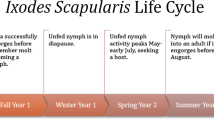Abstract
A stochastic model for Bovine Babesiosis (BB) including ticks, and both juvenile and adult cattle is developed. This model is formulated by a system of continuous-time Markov chains (CTMCs) that is derived based on an extension of the deterministic ordinary differential equation model developed by Saad-Roy et al. (Bull Math Biol 77:514–547, 2015). The nonlinear CTMC model is approximated by a multitype branching process, giving a theoretical estimate of the probability of an outbreak of BB. Unlike the deterministic dynamics where the basic reproduction number is a sharp threshold parameter, the stochastic model indicates that there is always a positive probability of disease extinction within the cattle population. For parameter values from Colombia data, conditional probability distributions are numerically obtained for the time to disease extinction or outbreak, and are found to depend on the host type at the initiation of infection. The models with and without the inclusion of juvenile cattle are compared, and our result highlights that neglecting juvenile bovine in the models may lead to faulty predictions of critical disease statistics: particularly, it may underestimate the risk of infection. Endemic disease prevalence in adult cattle is examined for certain parameter values in the corresponding deterministic model. Notably, with long-lasting immunity, increased tick to juvenile infectivity decreases the proportion of infectious adults.






Similar content being viewed by others
References
Abdelheq M, Belhamiti O, Bouzid L, Trejos DY, Valverde JC (2019) A predictive spatio-temporal model for bovine Babesiosis epidemic transmission. J Theor Biol 480:192–204
Allen LJS, Lahodny G Jr (2012) Extinction thresholds in deterministic and stochastic epidemic models. J Biol Dyn 6:590–611
Allen LJS, van den Driessche P (2013) Relations between deterministic and stochastic thresholds for disease extinction in continuous- and discrete-time infectious disease models. Math Biosci 243:99–108
Aranda DF, Trejos DY, Valverde JC, Villanueva RJ (2012) A mathematical model for Babesiosis disease in bovine and tick populations. Math Methods Appl Sci 35:249–256
Aranda DF, Trejos DY, Valverde JC (2017) A discrete epidemic model for bovine Babesiosis disease and tick populations. Open Phys 15:360–369
Bock R, Jackson L, de Vos A, Jorgensen W (2004) Babesiosis of cattle. Parasitology 129:S247–S269
Diekmann O, Heesterbeek JAP (2000) Mathematical epidemiology of infectious diseases. Wiley, West Sussex
Dorman KS, Sinsheimer JS, Lange K (2004) In the garden of branching processes. SIAM Rev 46:202–229
Friedman A, Yakubu AA (2014) A Bovine Babesiosis model with dispersion. Bull Math Biol 76:98–135
Gray JS, Estrada-Pena A, Zintl A (2019) Vectors of Babesiosis. Annu Rev Entomol 64:149–165
Harris TE (1963) The theory of branching processes. Springer, Berlin
Mosqueda J, Olvera-Ramirez A, Aguilar-Tipacamú G, Cantó GJ (2012) Current advances in detection and treatment of Babesiosis. Curr Med Chem 19:1504–1518
Rathinasamy V, Poole WA, Bastos RG, Suarez CE, Cooke BM (2019) Babesiosis vaccines: lessons learned, challenges ahead, and future glimpses. Trends Parasitol 35:622–635
Saad-Roy CM, Shuai Z, van den Driessche P (2015) Models of Bovine Babesiosis including juvenile cattle. Bull Math Biol 77:514–547
van den Driessche P, Watmough J (2002) Reproduction numbers and sub-threshold endemic equilibria for compartmental models of disease transmission. Math Biosci 180:29–48
Yusuf JJ (2017) Review of Bovine Babesiosis. J Vet Med Res 4:1090–1099
Zabel TA, Agusto FB (2018) Transmission dynamics of bovine anaplasmosis in a cattle herd. Interdiscip Perspect Infect Dis 2018:1–16
Acknowledgements
The authors would like to thank the anonymous reviewer and the editor for helpful comments. The research of PvdD is partially supported by NSERC Discovery Grants. This work was supported by a grant from the Simons Foundation (No. 317407, XW). CMSR acknowledges support from a Jamie Cassels Undergraduate Research Award (JCURA) of the University of Victoria; NSERC through a PGS-D; the Bill and Melinda Gates Foundation Grant OPP1091919 (to Bryan Grenfell); the RAPIDD program of the Science and Technology Directorate Department of Homeland Security and the Fogarty International Center, NIH (to Bryan Grenfell); and the James S. McDonnell Foundation 21st Century Science Initiative Collaborative Award in Understanding Dynamic and Multi-scale Systems (to Simon Levin and Ramanan Laxminarayan). XW and PvdD thank the American Institute of Mathematics where some of this research was discussed.
Author information
Authors and Affiliations
Corresponding author
Additional information
Publisher's Note
Springer Nature remains neutral with regard to jurisdictional claims in published maps and institutional affiliations.
Appendix A: Mean and Standard Derivation of Time to Disease Extinction or Outbreak
Appendix A: Mean and Standard Derivation of Time to Disease Extinction or Outbreak
Rights and permissions
About this article
Cite this article
Wang, X., Saad-Roy, C.M. & van den Driessche, P. Stochastic Model of Bovine Babesiosis with Juvenile and Adult Cattle. Bull Math Biol 82, 64 (2020). https://doi.org/10.1007/s11538-020-00734-x
Received:
Accepted:
Published:
DOI: https://doi.org/10.1007/s11538-020-00734-x




